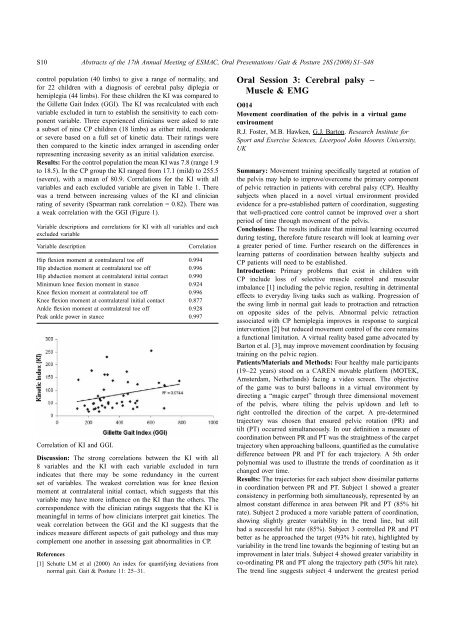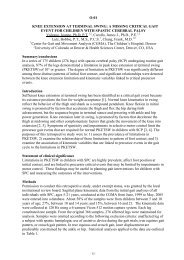Development of a 'Kinetic Index' - Análise de Marcha
Development of a 'Kinetic Index' - Análise de Marcha
Development of a 'Kinetic Index' - Análise de Marcha
You also want an ePaper? Increase the reach of your titles
YUMPU automatically turns print PDFs into web optimized ePapers that Google loves.
S10 Abstracts <strong>of</strong> the 17th Annual Meeting <strong>of</strong> ESMAC, Oral Presentations / Gait & Posture 28S (2008) S1–S48<br />
control population (40 limbs) to give a range <strong>of</strong> normality, and<br />
for 22 children with a diagnosis <strong>of</strong> cerebral palsy diplegia or<br />
hemiplegia (44 limbs). For these children the KI was compared to<br />
the Gillette Gait In<strong>de</strong>x (GGI). The KI was recalculated with each<br />
variable exclu<strong>de</strong>d in turn to establish the sensitivity to each component<br />
variable. Three experienced clinicians were asked to rate<br />
a subset <strong>of</strong> nine CP children (18 limbs) as either mild, mo<strong>de</strong>rate<br />
or severe based on a full set <strong>of</strong> kinetic data. Their ratings were<br />
then compared to the kinetic in<strong>de</strong>x arranged in ascending or<strong>de</strong>r<br />
representing increasing severity as an initial validation exercise.<br />
Results: For the control population the mean KI was 7.8 (range 1.9<br />
to 18.5). In the CP group the KI ranged from 17.1 (mild) to 255.5<br />
(severe), with a mean <strong>of</strong> 80.9. Correlations for the KI with all<br />
variables and each exclu<strong>de</strong>d variable are given in Table 1. There<br />
was a trend between increasing values <strong>of</strong> the KI and clinician<br />
rating <strong>of</strong> severity (Spearman rank correlation = 0.82). There was<br />
a weak correlation with the GGI (Figure 1).<br />
Variable <strong>de</strong>scriptions and correlations for KI with all variables and each<br />
exclu<strong>de</strong>d variable<br />
Variable <strong>de</strong>scription Correlation<br />
Hip flexion moment at contralateral toe <strong>of</strong>f 0.994<br />
Hip abduction moment at contralateral toe <strong>of</strong>f 0.996<br />
Hip abduction moment at contralateral initial contact 0.990<br />
Minimum knee flexion moment in stance 0.924<br />
Knee flexion moment at contralateral toe <strong>of</strong>f 0.996<br />
Knee flexion moment at contralateral initial contact 0.877<br />
Ankle flexion moment at contralateral toe <strong>of</strong>f 0.928<br />
Peak ankle power in stance 0.997<br />
Correlation <strong>of</strong> KI and GGI.<br />
Discussion: The strong correlations between the KI with all<br />
8 variables and the KI with each variable exclu<strong>de</strong>d in turn<br />
indicates that there may be some redundancy in the current<br />
set <strong>of</strong> variables. The weakest correlation was for knee flexion<br />
moment at contralateral initial contact, which suggests that this<br />
variable may have more influence on the KI than the others. The<br />
correspon<strong>de</strong>nce with the clinician ratings suggests that the KI is<br />
meaningful in terms <strong>of</strong> how clinicians interpret gait kinetics. The<br />
weak correlation between the GGI and the KI suggests that the<br />
indices measure different aspects <strong>of</strong> gait pathology and thus may<br />
complement one another in assessing gait abnormalities in CP.<br />
References<br />
[1] Schutte LM et al (2000) An in<strong>de</strong>x for quantifying <strong>de</strong>viations from<br />
normal gait. Gait & Posture 11: 25−31.<br />
Oral Session 3: Cerebral palsy –<br />
Muscle & EMG<br />
O014<br />
Movement coordination <strong>of</strong> the pelvis in a virtual game<br />
environment<br />
R.J. Foster, M.B. Hawken, G.J. Barton. Research Institute for<br />
Sport and Exercise Sciences, Liverpool John Moores University,<br />
UK<br />
Summary: Movement training specifically targeted at rotation <strong>of</strong><br />
the pelvis may help to improve/overcome the primary component<br />
<strong>of</strong> pelvic retraction in patients with cerebral palsy (CP). Healthy<br />
subjects when placed in a novel virtual environment provi<strong>de</strong>d<br />
evi<strong>de</strong>nce for a pre-established pattern <strong>of</strong> coordination, suggesting<br />
that well-practiced core control cannot be improved over a short<br />
period <strong>of</strong> time through movement <strong>of</strong> the pelvis.<br />
Conclusions: The results indicate that minimal learning occurred<br />
during testing, therefore future research will look at learning over<br />
a greater period <strong>of</strong> time. Further research on the differences in<br />
learning patterns <strong>of</strong> coordination between healthy subjects and<br />
CP patients will need to be established.<br />
Introduction: Primary problems that exist in children with<br />
CP inclu<strong>de</strong> loss <strong>of</strong> selective muscle control and muscular<br />
imbalance [1] including the pelvic region, resulting in <strong>de</strong>trimental<br />
effects to everyday living tasks such as walking. Progression <strong>of</strong><br />
the swing limb in normal gait leads to protraction and retraction<br />
on opposite si<strong>de</strong>s <strong>of</strong> the pelvis. Abnormal pelvic retraction<br />
associated with CP hemiplegia improves in response to surgical<br />
intervention [2] but reduced movement control <strong>of</strong> the core remains<br />
a functional limitation. A virtual reality based game advocated by<br />
Barton et al. [3], may improve movement coordination by focusing<br />
training on the pelvic region.<br />
Patients/Materials and Methods: Four healthy male participants<br />
(19−22 years) stood on a CAREN movable platform (MOTEK,<br />
Amsterdam, Netherlands) facing a vi<strong>de</strong>o screen. The objective<br />
<strong>of</strong> the game was to burst balloons in a virtual environment by<br />
directing a “magic carpet” through three dimensional movement<br />
<strong>of</strong> the pelvis, where tilting the pelvis up/down and left to<br />
right controlled the direction <strong>of</strong> the carpet. A pre-<strong>de</strong>termined<br />
trajectory was chosen that ensured pelvic rotation (PR) and<br />
tilt (PT) occurred simultaneously. In our <strong>de</strong>finition a measure <strong>of</strong><br />
coordination between PR and PT was the straightness <strong>of</strong> the carpet<br />
trajectory when approaching balloons, quantified as the cumulative<br />
difference between PR and PT for each trajectory. A 5th or<strong>de</strong>r<br />
polynomial was used to illustrate the trends <strong>of</strong> coordination as it<br />
changed over time.<br />
Results: The trajectories for each subject show dissimilar patterns<br />
in coordination between PR and PT. Subject 1 showed a greater<br />
consistency in performing both simultaneously, represented by an<br />
almost constant difference in area between PR and PT (85% hit<br />
rate). Subject 2 produced a more variable pattern <strong>of</strong> coordination,<br />
showing slightly greater variability in the trend line, but still<br />
had a successful hit rate (85%). Subject 3 controlled PR and PT<br />
better as he approached the target (93% hit rate), highlighted by<br />
variability in the trend line towards the beginning <strong>of</strong> testing but an<br />
improvement in later trials. Subject 4 showed greater variability in<br />
co-ordinating PR and PT along the trajectory path (50% hit rate).<br />
The trend line suggests subject 4 un<strong>de</strong>rwent the greatest period
















